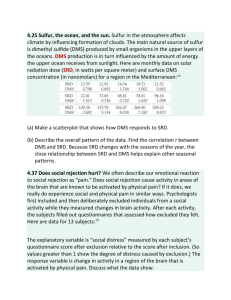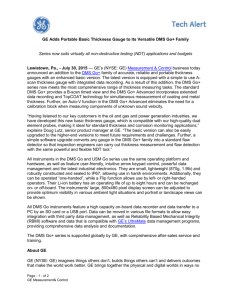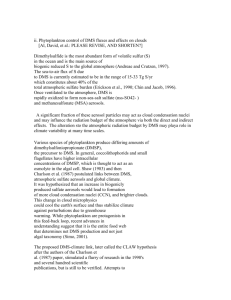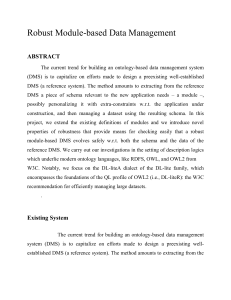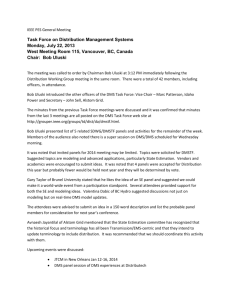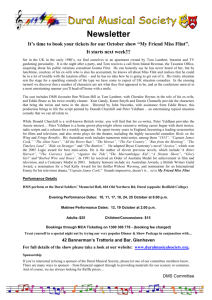gabric2
advertisement
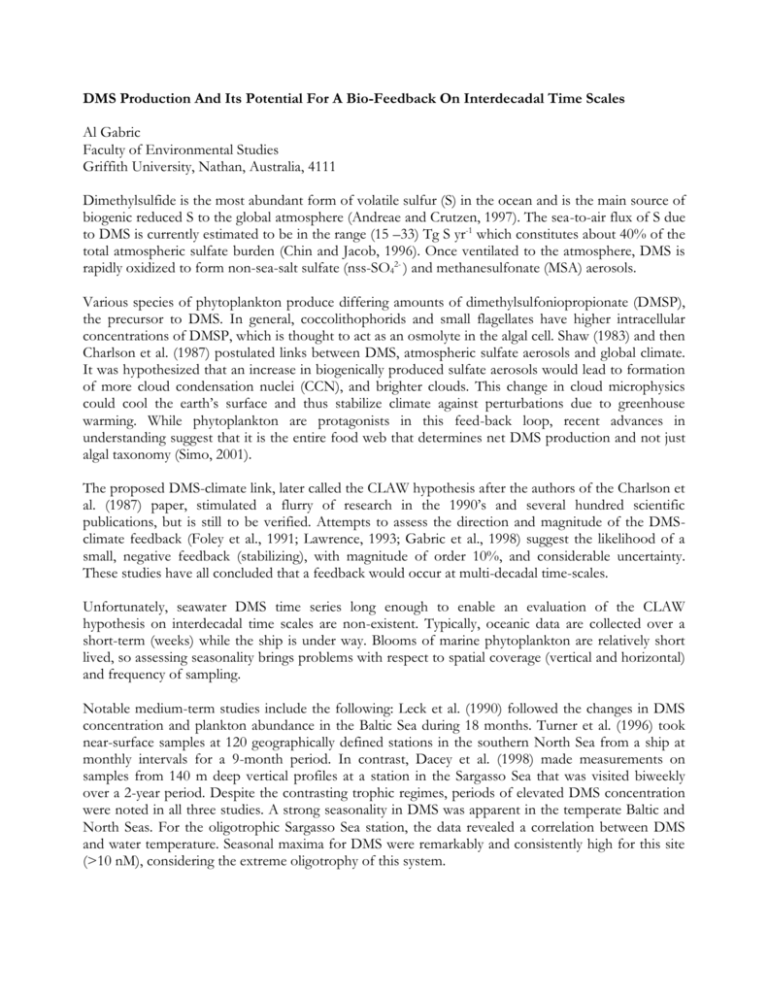
DMS Production And Its Potential For A Bio-Feedback On Interdecadal Time Scales Al Gabric Faculty of Environmental Studies Griffith University, Nathan, Australia, 4111 Dimethylsulfide is the most abundant form of volatile sulfur (S) in the ocean and is the main source of biogenic reduced S to the global atmosphere (Andreae and Crutzen, 1997). The sea-to-air flux of S due to DMS is currently estimated to be in the range (15 –33) Tg S yr-1 which constitutes about 40% of the total atmospheric sulfate burden (Chin and Jacob, 1996). Once ventilated to the atmosphere, DMS is rapidly oxidized to form non-sea-salt sulfate (nss-SO42- ) and methanesulfonate (MSA) aerosols. Various species of phytoplankton produce differing amounts of dimethylsulfoniopropionate (DMSP), the precursor to DMS. In general, coccolithophorids and small flagellates have higher intracellular concentrations of DMSP, which is thought to act as an osmolyte in the algal cell. Shaw (1983) and then Charlson et al. (1987) postulated links between DMS, atmospheric sulfate aerosols and global climate. It was hypothesized that an increase in biogenically produced sulfate aerosols would lead to formation of more cloud condensation nuclei (CCN), and brighter clouds. This change in cloud microphysics could cool the earth’s surface and thus stabilize climate against perturbations due to greenhouse warming. While phytoplankton are protagonists in this feed-back loop, recent advances in understanding suggest that it is the entire food web that determines net DMS production and not just algal taxonomy (Simo, 2001). The proposed DMS-climate link, later called the CLAW hypothesis after the authors of the Charlson et al. (1987) paper, stimulated a flurry of research in the 1990’s and several hundred scientific publications, but is still to be verified. Attempts to assess the direction and magnitude of the DMSclimate feedback (Foley et al., 1991; Lawrence, 1993; Gabric et al., 1998) suggest the likelihood of a small, negative feedback (stabilizing), with magnitude of order 10%, and considerable uncertainty. These studies have all concluded that a feedback would occur at multi-decadal time-scales. Unfortunately, seawater DMS time series long enough to enable an evaluation of the CLAW hypothesis on interdecadal time scales are non-existent. Typically, oceanic data are collected over a short-term (weeks) while the ship is under way. Blooms of marine phytoplankton are relatively short lived, so assessing seasonality brings problems with respect to spatial coverage (vertical and horizontal) and frequency of sampling. Notable medium-term studies include the following: Leck et al. (1990) followed the changes in DMS concentration and plankton abundance in the Baltic Sea during 18 months. Turner et al. (1996) took near-surface samples at 120 geographically defined stations in the southern North Sea from a ship at monthly intervals for a 9-month period. In contrast, Dacey et al. (1998) made measurements on samples from 140 m deep vertical profiles at a station in the Sargasso Sea that was visited biweekly over a 2-year period. Despite the contrasting trophic regimes, periods of elevated DMS concentration were noted in all three studies. A strong seasonality in DMS was apparent in the temperate Baltic and North Seas. For the oligotrophic Sargasso Sea station, the data revealed a correlation between DMS and water temperature. Seasonal maxima for DMS were remarkably and consistently high for this site (>10 nM), considering the extreme oligotrophy of this system. Bates and Quinn (1997) collated data from 11 cruises in the Equatorial Pacific undertaken from 1982 to 1996. They reported that mean DMS levels during El Nino periods were not significantly different from those in normal years. It should be noted that the cruise data were all short-term (< a month), so that a proper interannual comparison was not possible. Despite the major physical changes that occurred during the well-documented 1992 El Nino, the chemical and biological variability was small (Murray et al. 1994). Even though primary production decreased during the ENSO event, this appeared to be due to a reduction in the numbers of larger diatoms, which are not major DMS producers. In contrast to the Bates and Quinn (1997) study, Legrand and Feniet-Saigne (1991) found a good correlation between El Nino events and high MSA concentrations in south polar snow layers deposited over the 1922-1984 time period presumably due to enhanced DMS concentrations at high southern latitudes during El Nino years. Legrand and Feniet-Saigne (1991) suggest this could have been due to higher sea surface wind speed (implying increased sea-to-air exchange), or variations in sea-ice cover, which can affect ocean salinity and hence the osmotic balance in the algal cell for which DMSP is thought to have a regulating role. Analysis of an 8-year time series of atmospheric measurements at Cape Grim, Tasmania (40°41'S, 144° 41'E), illustrates the strong seasonality in DMS, and has confirmed the connection between atmospheric DMS and aerosol sulfur species in this region (Ayers et al., 1991; Boers et al., 1994). A multi-decadal times eries of MSA observations at Cape Grim is shown in Figure 1. Although there is considerable interannual variability in the magnitude of the MSA peak, the strong seasonality and early January timing of the MSA maximum is remarkably consistent. In the absence of long-term oceanic time series, modeling can provide some insights into the potential for an interdecadal feedback. Gabric et al (in press) forced a regional DMS production model in the Subantarctic Southern Ocean with data on temperature, cloud, wind speed and mixed layer depth under enhanced greenhouse conditions derived from a coupled general circulation model. The GCM and DMS models were run in transient mode over the time period 1961-2080. Interestingly, the results ( Figure 2) showed considerable interdecadal variability in the annual integrated DMS flux, suggesting the potential for a significant DMS response to changes in the physical forcings. Acknowledgements The MSA data was kindly provided by Dr Greg Ayers, CSIRO Atmospheric Research (Melbourne). This work was partially supported by an ARC Large Grant. References Andreae M.O. and Crutzen, P.J. 1997. Atmospheric aerosols: Biogeochemical sources and role in atmospheric chemistry, Science 276, 1052-1058 Ayers, G.P., Ivey, J.P., and Gillett, R.W. 1991. Coherence between seasonal cycles of dimethylsulfide, methanesulphonate and sulphate in marine air. Nature, 349, 404-406. Bates, T.S., and Quinn, P.K. 1997. Dimethylsulfide (DMS) in the equatorial Pacific Ocean (1982 to 1996): evidence of a climate feedback? Geophys. Res. Lett. 24, 861-864. Boers, R., Ayers, G.P., and Gras, J.L. 1994. Coherence between seasonal variation in satellite-derived cloud optical depth and boundary-layer CCN concentrations at a midlatitude Southern hemisphere station. Tellus, B 46, 123-131. Charlson, R.J., Lovelock, J.E., Andreae, M.O. and Warren, S.G., 1987. Oceanic phytoplankton, atmospheric sulphur, cloud albedo and climate. Nature, 326, 655-661. Chin, M., and Jacob, D. J. 1996. Anthropogenic and natural contributions to tropospheric sulfate: a global model analysis. J. Geophys. Res. 101, 18691-18699. Dacey, J.W.H., Howse, F.A., Michaels, A.F., and Wakeham, S.G., 1998. Temporal variability of dimethylsulfide and dimethylsulfoniopropionate in the Sargasso Sea. Deep Sea Research 45, 2085-2104. Gabric, A.J., Whetton, P., and Cropp, R. Dimethylsulphide production in the subantarctic Southern Ocean under enhanced greenhouse conditions. Tellus (to appear) Leck, C., Larsson, U., Bågander, L. E., Johansson, S. and Hajdu, S., 1990. DMS in the Baltic Sea Annual variability in relation to biological activity. Journal of Geophysical Research 95 (C3), 33533363. Legrand, M., and Feniet-Saigne, C. 1991. Methanesulfonic acid in south polar snow layers: A record of strong El Nino ? Geophysical Research letters, 18, 187-190. Murray, J.W., Barber, R.T., Roman, M.R., Bacon, M.P. and Feely, R.A. 1994. Physical and biological controls on carbon cycling in the equatorial Pacific. Science, 266, 58-65. Shaw, G.E., 1983. Bio-controlled thermostasis involving the sulphur cycle. Climate Change, 5, 297-303. Simo, R. 2001. Production of atmospheric sulfur by oceanic plankton: biogeochemical, ecological and evolutionary links. Trends in Ecology & Evolution, 16, 287-294. Turner, S.M., Malin, G., Nightingale, P.D. and Liss, P.S., 1996. Seasonal variation of dimethylsulphide in the North Sea and an assessment of fluxes to the atmosphere. Marine Chemistry 54:245-262. 1-Jan-00 1-Jan-99 1-Jan-98 1-Jan-97 1-Jan-96 1-Jan-95 1-Jan-94 1-Jan-93 1-Jan-92 1-Jan-91 1-Jan-90 1-Jan-89 1-Jan-88 1-Jan-87 1-Jan-86 1-Jan-85 1-Jan-84 1-Jan-83 1-Jan-82 1-Jan-81 1-Jan-80 1-Jan-79 1-Jan-78 Concentration nmol m -3 Figure 1 MSA concentrations measured at Cape Grim (Tasmania) 1978-2000. MSA Time Series Cape Grim 3 2.5 2 1.5 1 0.5 0 Figure 2. Model simulation of the trend in annual DMS flux in Subantarctic Southern Ocean Trend in Annual Flux (Baseline Parameters) 2200 2 DMS Flux ( mole/m ) 2000 Trend line: y = 0.5696x + 1429.5 1800 1600 1400 1200 1000 1961 1970 1979 1988 1997 2006 2015 2024 2033 2042 2051 2060 2069 2078
